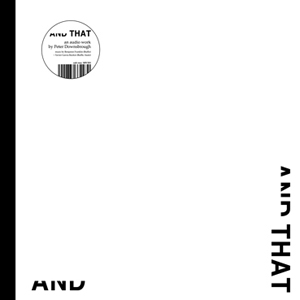An audio work by Peter Downsbrough, in collaboration with two musicians of the Buffle collective Xavier Garcia-Bardon and Benjamin Franklin.
The music Downsbrough commissioned for the final edit of this LP (only available on vinyl) was composed
and recorded in 2007 by Xavier Garcia-Bardon and Benjamin Franklin as
a semi-improvisation (a modus operandi they first experimented in the
Belgian collective Buffle): a mix of ambient electric guitar, sweet electro, street
field recordings, treatments and voices.
As is often the case with
Downsbrough, the final piece seems to be emerging from a world put
between parentheses - music that could last forever, where fragments
seem to be missing (just like in his typographical work). It's those missing
bits we ceaselessly try to find in this music without beginning or end.
500 copies limited edition.
The work of visual artist, photographer and film artist Peter Downsbrough (1940-2024)
has had a major impact on the perception of art. The varied work of the artist—ranging from sculpture and books to photography,
video, and film—maintained a complex relationship with architecture and
typography, while also drawing on the achievements of the early avant-garde
(Bauhaus, De Stijl) and Minimal Art.
In terms of form, the work of Downsbrough
is highly rigorous and exhibits a powerful geometric sense, restricting itself
primarily to the use of line, plane, negative space (cutting away), and
delimitation. In addition to his spatial manipulations, the artist also has
a keen interest in place, as is evidenced in his cartographical works and
city photographs.
Downsbrough studied architecture and art. Around the mid-1960s, after several years of work and exploring materials, an evolution took place with resulted, in 1970, in the work with the Two Pipes (outside), Two Dowels (inside), and Two Lines (on paper). At the same time, he also started taking photographs to document these pieces. Buy taking photographs of "cuts" that already existed in the urban landscape. Some of these photographs were used in books, some appeared in magazines, but it wasn't until 1960 that they showed up in exhibitions. From 1977 on, Downsbrough realized several videos as well as audiotapes. A record was made in 1978 and released in 1982. In 1980, on the Spectacolor Board on Times Square, N.Y., he realized a piece, a 30 second spot shown once every hour for four days and documented it in a short film, "7 come 11". The work with maquettes as a means of exploring space and structure started around 1983. The first commissioned public work was a wall piece realized in Rennes, France, 1990.

